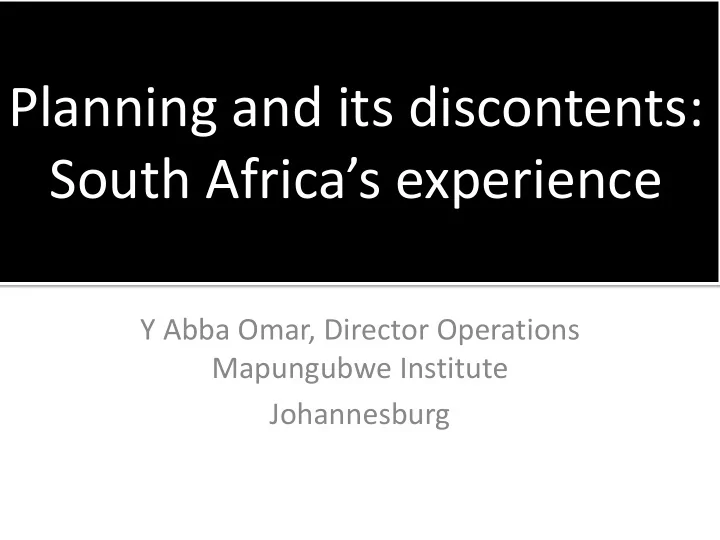

Planning and its discontents: South Africa’s experience Y Abba Omar, Director Operations Mapungubwe Institute Johannesburg
While the focus is on impact, it becomes necessary to examine the processes which were undertaken, some of the content and, most importantly, the context .
The Alphabet Soup of Plans • RDP • GEAR • ASGISA • NGP • IPAP • NDP – Developmental state – Contestation
Reconstruction and Development Programme “Inevitably, the goals of the RDP are ambitious: embedding democracy; disentangling the costly and debilitating legacy of apartheid; accelerating economic growth and new opportunities; delivering affordable services equitably; and fundamentally transforming society, the economy and all spheres of government. Against this background …the achievements of the RDP should not be measured only by the scale of delivery but also by its sustainability”. Ian Goldin and Chris Heymans. ‘Moulding a new society: The RDP in perspective’. In Between Unity and Diversity: Essays on Nation-building in post-apartheid South Africa , ed Gitanjali Maharaj. (Cape Town: David Philip Publishers, 1999) , 111 (109-122)
How South Africans scratch their left ear, according to a visiting Minister of Housing of India
Growth, Employment and Redistribution Framework • “A national vision to lift us out of this quagmire”, Nelson Mandela 1996 • “Comrades appear to have forgotten that, having noted the fiscal crisis, characterised in part by a large budget deficit, and having called for new macroeconomic ratios, the RDP did not then go on to say that what these ratios should be. For some strange reason, when work is done to translate the perspective contained in the RDP into actual figures, this is then interpreted as a replacement of the RDP by GEAR”, Thabo Mbeki
Accelerated Shared Growth Initiative of South Africa • Focused on six key “binding constraints” • Macroeconomic issues; infrastructure programmes; industrial strategies; skills and education interventions; interventions in what was referred to as the second economy; and public administration issues.
Industrial Policy Action Plan • SA’s competitive edge: natural resources; medium- technology sectors; advanced manufacturing and labour-intensive sectors. • Other areas addressed: industrial financing; trade policy; skills and education; competition policy; public expenditure; upgrading of existing sectors; fostering of R&D; addressing the spatial inequalities of apartheid; supporting SMMEs; Black Economic Empowerment; addressing linkages with trade in Africa and improvements in the state agencies impacting on industry.
New Growth Path • “1. Identifying areas where employment creation is possible on a large scale. • 2. a. Drive to enhance both social equity and competitiveness; • b. Mobilise domestic investment; • c. Strong social dialogue to focus all stakeholders on encouraging growth in employment-creating activities”.
The Developmental State • Chalmer’s Johnson (1982) MITI’s role in Japan • Robert Wade (1990) ‘Govern the Market’ • Differed in political systems, dependence on international capital markets, SOEs, industrial strategies, FDI • Linda Weiss (2010) myths: – DS necessarily authoritarian – Top-down centralised planning – Trade off welfare and equity for growth – Right politics – Unitary totality needing massive engineering
What did DS do? • Common denominator: external impetus (Weiss) – Security: Taiwan, Korea, Singapore. – Catch-up: China • Strategic Industry Policy • Incentive structure linked to performance, protection time limited • Administrative guidance
State Capacity • State’s prioritization • Political will – need to institutionalise commitment • Shared background of professional cadres • Pilot agency insulated from corruption etc but highly connected to economy – Japan’s METI, Taiwan’s IDB,
National Development Plan: Diagnostic Report 2011 • Nine key challenges • Extremely high level of unemployment; • Poor school education for black people; • Infrastructure that is poorly located, inadequate and under-maintained; • Spatial divides inherited from the apartheid era; • Economy that is too resource intensive; • Poor public health system; • Uneven public services; • High levels of corruption • Divisions within South African society.
NDP Approach • Uniting all South Africans around a common programme; • Promoting active citizenry; • Bringing about faster economic growth, higher investment and greater labour absorption; • Focusing on the capabilities of the people and the state; • Building a capable and developmental state; • Encouraging strong leadership throughout society to work together to solve problems.
NDP: Targets by 2030 • Reducing the proportion of people living below the level of R418 (at 2009 figures) from the current 39 per cent of the population to zero, • Reducing unemployment to 6per cent in 2030 by creating eleven million jobs; • Manufacturing sectors growing by 50per cent along the lines envisaged in the IPAP and the NGP; • Lowering the cost of living for the poorest by containing prices of basic commodities, spatial interventions that reduce workers’ expenditure on transport, the social safety net, and free basic services.
Mother of all battles Helen Zille, leader of the opposition Democratic Alliance, said “it • points to an emerging consensus at the non-racial, progressive centre of South African politics” Jeremy Cronin, SACP: impossible to implement, inequality reduction • “pathetic”, weak on re-industrialisation, infrastructure provision and skills development. Cosatu: • – The definition of unemployment in the NDP is narrow and does not include those who have been discouraged from seeking employment. – Its target of 11 million job has “too many low-quality and unsustainable jobs” as opposed to “decent work”. Also, it depends disproportionately on exports, the SMME and service sectors, unlike the IPAP and NGP commitment to reindustrialising the economy. – The NDP accepts a high level of inequality persisting until 2030. The bottom 40 per cent of society will have income of only 10 per cent of the total in 2030, from the current 6 per cent.
Conclusion • Processes – Does it matter? – Can stymie implementation • Content – Ideological leaning versus Need for sharply focused interventions • Context – Global and regional economic development • Impact – Need to agree on targets
Recommend
More recommend